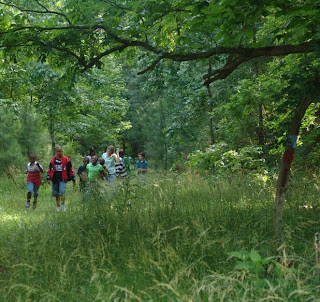
Wannamaker Nature Preserve is owned by the Columbia Audubon Society chapter with educational programming provided by the Audubon Center at Francis Beidler Forest. Although the trails have existed for years, the lack of a shelter, bus access and parking, and restrooms have prevented local Calhoun County schools from using the outdoor laboratory. That all changed this week with 3rd graders visiting on Tuesday and 4th graders visiting on Wednesday!

Even though the restroom will not be installed until next month, the proximity to the schools (7-minute bus ride) and the brief time at the preserve allowed schools to work around the issue. As noted in earlier blogs (1, 2, 3), the driveway, parking and shelter issues had already been resolved.
These first visits were intended to familiarize students and teachers with the site. Chris Russell runs the elementary school science lab and was the liason between Audubon and the Calhoun County School District. The 3rd graders walked along the trails and reported what they saw to the adult  recorders. The lists included: Southern Toad, Ebony Jewelwing Damselfly, fungus, spiders (multiple species!), poison ivy, pine trees, sweetgums, deer tracks, blackberries, ants and ant piles, lizards, Blue Jays, Yellow-billed Cuckoo, flowering Spanish Moss, funnel web spiders, dragonflies, mosquitoes, ticks (yuck!), ferns, grasses, acorns, pecans, Carolina Wren nest in shelter, etc. Back in the classroom, students will create food chains and food webs based on the organisms they encountered during their walk!
recorders. The lists included: Southern Toad, Ebony Jewelwing Damselfly, fungus, spiders (multiple species!), poison ivy, pine trees, sweetgums, deer tracks, blackberries, ants and ant piles, lizards, Blue Jays, Yellow-billed Cuckoo, flowering Spanish Moss, funnel web spiders, dragonflies, mosquitoes, ticks (yuck!), ferns, grasses, acorns, pecans, Carolina Wren nest in shelter, etc. Back in the classroom, students will create food chains and food webs based on the organisms they encountered during their walk!

 recorders. The lists included: Southern Toad, Ebony Jewelwing Damselfly, fungus, spiders (multiple species!), poison ivy, pine trees, sweetgums, deer tracks, blackberries, ants and ant piles, lizards, Blue Jays, Yellow-billed Cuckoo, flowering Spanish Moss, funnel web spiders, dragonflies, mosquitoes, ticks (yuck!), ferns, grasses, acorns, pecans, Carolina Wren nest in shelter, etc. Back in the classroom, students will create food chains and food webs based on the organisms they encountered during their walk!
recorders. The lists included: Southern Toad, Ebony Jewelwing Damselfly, fungus, spiders (multiple species!), poison ivy, pine trees, sweetgums, deer tracks, blackberries, ants and ant piles, lizards, Blue Jays, Yellow-billed Cuckoo, flowering Spanish Moss, funnel web spiders, dragonflies, mosquitoes, ticks (yuck!), ferns, grasses, acorns, pecans, Carolina Wren nest in shelter, etc. Back in the classroom, students will create food chains and food webs based on the organisms they encountered during their walk!

The 4th graders saw much of the same life when they visited the next day.  However, they took their visit up a notch by creating an event map of their experience. Working in pairs, students sketched their path through the preserve, made notes of their observations, and sketched items of interest. Therefore, each map had similarities (picnic shelter, trail, driveway), but each map was unique based on the creators' interests (not every student added ticks or spiders). Things were going quite well for the first group as we were about to complete the full blue trail circuit. Five minutes from the shelter, the sky opened and rained for exactly five minutes. We were soaked, all the maps disintegrated, but there was nothing but laughter. The second group fared better when it came to the weather.
However, they took their visit up a notch by creating an event map of their experience. Working in pairs, students sketched their path through the preserve, made notes of their observations, and sketched items of interest. Therefore, each map had similarities (picnic shelter, trail, driveway), but each map was unique based on the creators' interests (not every student added ticks or spiders). Things were going quite well for the first group as we were about to complete the full blue trail circuit. Five minutes from the shelter, the sky opened and rained for exactly five minutes. We were soaked, all the maps disintegrated, but there was nothing but laughter. The second group fared better when it came to the weather.
 However, they took their visit up a notch by creating an event map of their experience. Working in pairs, students sketched their path through the preserve, made notes of their observations, and sketched items of interest. Therefore, each map had similarities (picnic shelter, trail, driveway), but each map was unique based on the creators' interests (not every student added ticks or spiders). Things were going quite well for the first group as we were about to complete the full blue trail circuit. Five minutes from the shelter, the sky opened and rained for exactly five minutes. We were soaked, all the maps disintegrated, but there was nothing but laughter. The second group fared better when it came to the weather.
However, they took their visit up a notch by creating an event map of their experience. Working in pairs, students sketched their path through the preserve, made notes of their observations, and sketched items of interest. Therefore, each map had similarities (picnic shelter, trail, driveway), but each map was unique based on the creators' interests (not every student added ticks or spiders). Things were going quite well for the first group as we were about to complete the full blue trail circuit. Five minutes from the shelter, the sky opened and rained for exactly five minutes. We were soaked, all the maps disintegrated, but there was nothing but laughter. The second group fared better when it came to the weather.Images by Mark Musselman











































